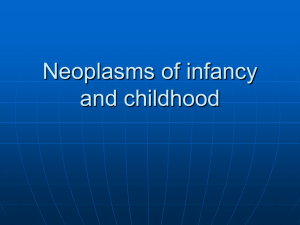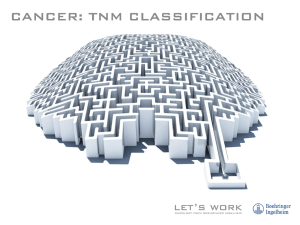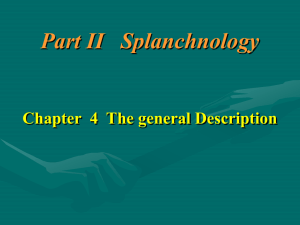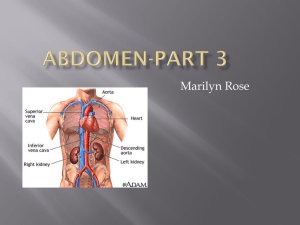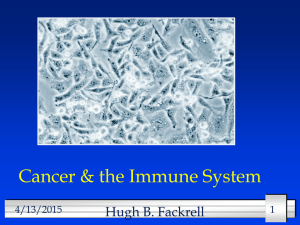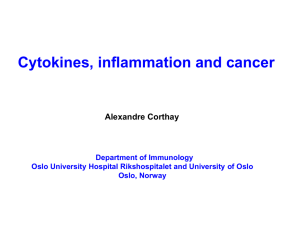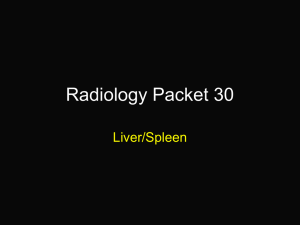Abdominal tumors in children
advertisement
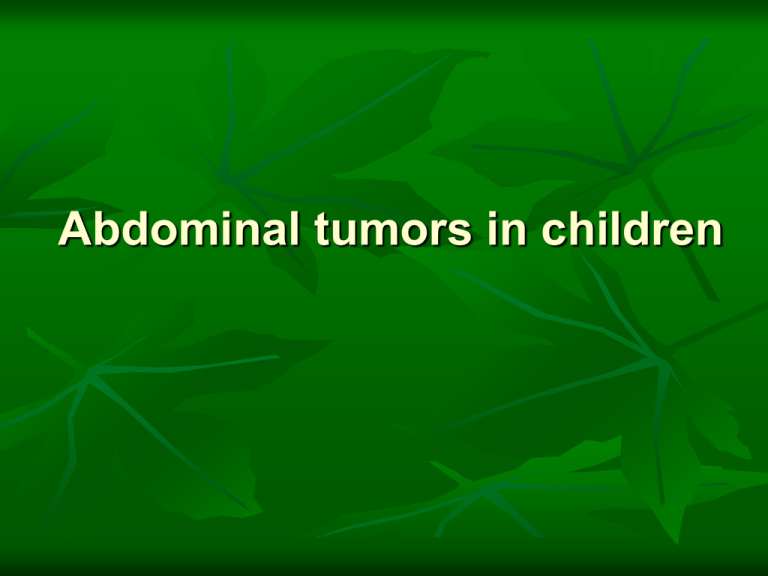
Abdominal tumors in children Abdominal tumor ≠ abdominal neoplasm In neonatal and infantile period the majority of palpable masses in abdomen are anomalous or enlarged organs . Congenital abnormalities of kidneys are the cause of 55% of all unilateral and 90% of bilateral abdominal masses in newborns and infants Newborns and infants (< 2 year of life) Unilateral abdominal tumours: • Kidneys – 55% hydronephrosis multicystic dysplastic kidney mesoblastic nephroma • Retroperitoneal cavity (besides kidneys) – 15% adrenal haematoma neuroblastoma teratoma • Gastrointestinal system – 15% duplications Bilateral abdominal masses: • Genital system – 10% • Kidneys (90%) ovary cyst polycystic kidneys diseases Hydromethrocolpos ADPKD, ARPKD • Liver – 5% hepatoblastoma Toddlers and older children (>2 year of life) • Kidneys (45%) Wilms tumour (nephroblastoma) hydronephrosis • Retroperitoneal cavity (40%) (adrenal glands, autonomic ganglions, lymph nodes) neuroblastoma teratona lymphoma • Gastrointestinal system (15%) - liver, splen, bowels lymphoma duplications hepatoblastoma Retroperitoneal cavity BENIGN TUMOURS: Adrenal - haematoma Kidney enlargement – hydronephrosis, abscess, renal veins thrombosis MALIGNANCIES: Renal – Wilms tumour Lymph nodes – lymphoma adrenals and autonomic ganglions – neuroblastoma Diagnostic algorithm in children with palpable abdominal tumour USG and plain abdominal rentgenogram – cystic mass: KIDNEYS ADRENALS LIVER PANCREAS Voiding cystoureterography control usg (in 2-3 weeks) scyntygraphy control usg scyntygraphy/u rography computed tomography computed tomography (if necessary) hydronephrosis cysts post / multicystic haematoma dysplastic/ ADPKD cysts/ ADPKD post-traumatic pseudocyst Diagnostic algorithm in children with palpable abdominal tumour USG and plain abdominal rentgenogram – solid mass: KIDNEY ADRENAL LIVER LYMPH NODES computed tomography Bones scintigraphy computed tomography computed tomography Chest Catecholamine α- fetoprotein radiogram/ level level chest computed tomography Wilms tumour/ neuroblastoma hepatoblastoma lymphoma mesoblastic nephroma in infants Abdominal tumors in children Hydronephrosis in infant bilateral, more pronounced on the right Abdominal tumors in children Unilateral hydronephrosis Abdominal tumors in children Newborn – adrenal haematoma Abdominal tumors in children ADRENAL HEMATOMA - detection by ultrasound (hypoechoic mass above the upper pole of the kidney, mixed echogenicity with hyperechoic areas are possible) - follow up examination to demonstrate volume regression - calcifications in follow-up studies - difficult to distinguish from neuroblastoma (laboratory findings- catecholamine metabolites in urine can help) - MRI or CT is not necessary in early detection after birth. Only in suspicious neuroblastoma for any other reason, is further imaging necessary. If volume regression is absent, MRI becomes necessary. Hyperintense T1w signal is indicative of hemorrhage. Abdominal tumors in children Autosomal recessive policystic kidney disease urography: bilateral massive enlargement of kidneys Abdominal tumors in children Autosomal recessive policystic kidney disease CT Abdominal tumors in children WILMS tumour Case 1: This well 5-year-old child presented with a left-sided abdominal mass. Ultrasound revealed a large rounded soft tissue mass arising from the kidney. A CT examination was performed . • What are the imaging features shown? • What are the differentiating features that allow a provisional diagnosis to be made? • What other investigation should be performed? • post contrast CT shows a well defined soft tissue mass in the left upper quadrant there is normal enhancing renal tissue inferior to the mass there is some displacement of the surrounding structures but no encasement there is no visible calcification • the diagnosis of a Wilm’s tumour is made upon the age of the child, the fact that the child is relatively well, the tumour is displacing surround structures rather than encasing them and there is an absence of calcification seen on the CT examination. • the staging Wilm’s tumour is open to debate. In some centres the presence of chest metastases is determined by a chest X-ray while other centres may perform chest CT. With all abdominal imaging is important to stage the tumour and in particular to look for the presence of tumour spread of the renal vein and into the inferior vena cava. Abdominal tumors in children Cystic nephroblastoma WILMS tumour Abdominal tumors in children NEPHROBLASTOMA (WILMS’ TUMOUR) is the most common renal tumour in childhood occur mainly in children of less than 5 years (peak incidence between 2 and 5 years of age) asymptomatic, occasionally fever, pain and hypertension may be present preferred locations for metastases are the locoregional lymph nodes and the lung (‘cannonball’ metastases). Liver metastases are possible. Other distant metastases, e.g. in the skeletal system, are rare. in the first 6 months of life, mesoblastic nephroma occurs more often than Wilms’ tumour. Abdominal tumors in children NEPHROBLASTOMA (WILMS’ TUMOUR) US is the fundamental imaging method MRI preferred for local tumour extension and abdominal metastases - homogeneous or inhomogeneous renal mass (bilateral involvement in 10% of cases) - displacement of neighbouring anatomical structures - echogenic tumour thrombus in renal vein or inferior vena cava (as the tumor often grows directly into the renal veins or IVC) - lymph node enlargement - tumour bleeding with central fluid/sedimentation levels - cystic tumours with tumour parenchyma are found in the case of cystic nephroblastoma Abdominal tumors in children NEPHROBLASTOMA (WILMS’ TUMOUR) • MR - hypointense pseudocapsule in T2w sequences - in T2 hyper- and T1 hypointensive renal mass with displacement of other organs - hyperintense tumour thrombus in hypointense vessel signal in T2w sequences - contrast enhancement of residual renal parenchyma, contrast enhancement of vital tumour areas, hypointense tumour necrosis - hyperintensive bleeding in the tumour in T1w sequences • CT - hyperdense areas in case of bleeding in native scans - calcifications in about 14% of nephroblastomas - inhomogeneous enhancement after contrast administration Abdominal tumors in children Adrenal neuroblastoma Case 2: A 2-year-old child presented with a large intra-abdominal mass. There was associated vomiting and weight loss. A CT and nuclear medicine study were performed. • What are the CT findings? • What is the nuclear medicine study and what does it show? • What is the overall diagnosis? • the CT examination shows a large abdominal mass that is calcified and encases the great vessels. These are the imaging features of a neuroblastoma • the nuclear medicine study is a meta-iodo-benzyl-guanidine (MIBG) study. An MIBG is used to detect skeletal metastases in children with neuroblastoma(MIBG as an analogon of catecholamine precursors is taken up in neuroblastoma and other neuro-endocrine tissue. Normally the skeleton should have no areas of increased activity. In this case there is marked uptake seen at the ends of the long bones indicting skeletal metastases. There is also activity in the centre of the abdomen within the primary tumour. • normal activity on an MIBG scan is seen within the salivary glands, spleen, liver and myocardium.This study involved the use of radioactive iodine, as such the thyroid should be protected by the use of blocking agents. In children this is usually performed by giving potassium perchlorate 3 days prior to the study Abdominal tumors in children NEUROBLASTOMA is most frequently diagnosed in infants below the age of 5 years originate in neural crest cells of the sympathetic nervous system. Nearly 70% of neuroblastomas arise in the abdomen. A typical location (about 50%) is the adrenal gland. the tumour extends to surrounding tissue by local invasion and to regional lymph nodes. metastatic spread in bone marrow, skeleton and liver is frequent. More than 50% of patients have metastatic disease. tumours localized to one side of the abdomen often cross the midline. frequently secrete neurogenically derived substances, e.g.catecholamine metabolites or neuron specific enolase. Abdominal tumors in children NEUROBLASTOMA Primary diagnosis is performed with ultrasound. Imaging studies include local staging with MRI or CT of the tumour region and chest radiograph. Bone scan and meta-iodobenzylguanidine (MIBG) scintigram define sites of metastases and demonstrate tumour response to chemotherapy. Possible findings: - encasement of retroperitoneal vessels - ventral displacement of aorta and vena cava - stippled tumour calcifications - single tumour of the adrenal gland - extended tumour mass in the retroperitoneum - infiltration of adjacent organs - infiltration into neuroforamen
